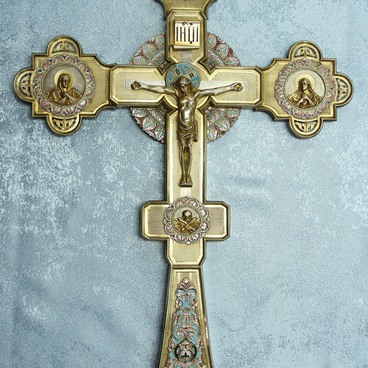The author of the four-part icon was a local painter, however, he must have been a native of Mogilev. Researchers believe that following his recommendations the icon of the Rudenskaya Theotokos was included into the composition as this image was widely spread in the Mogilev Eparchy. The Rudenskaya Theotokos is painted on the right side of the lower part.
The Iviron Theotokos is painted on the left side of the upper part. The icon belongs to a family of images of the Theotokos known as Hodigitria or She who points the Way. The Child Jesus is painted on his mother’s arms on such icons. According to the legend, the most ancient Iviron Theotokos appeared in the 9th century. It was found near the walls of the Iviron Monastery on Mount Athos. Three copies were brought to Moscow. The images of Moscow Saints Peter, Alexius, Jonah, and Philip are added to the image of the Iviron Theotokos.
The Bogolubskaya Icon of the Theotokos is placed on the right side of the upper part. It is painted following the tradition of icon painting of the 12th century. At that time, the icon was painted at the request of Grand Prince Andrew Bogolubsky. The Theotokos is depicted in full stature on the icon from the Rybinsk Museum Reserve. She is turned in prayer to Jesus Christ and Saint Prince Andrew Bogolubsky, Saint Anysia of Salonika and the Great Martyr Barbara are depicted in a prayerful stance on their knees before the Theotokos. The Mikhalkovs often ordered to paint saints names of which were given to members of their family. The size of a figure on the icon corresponded to the age of a person who was named after this saint as the older the person was, the bigger the saint was painted on the icon.
The Theotokos icon Discovery of Mind is on the left side of the lower part of the composition. The tradition of this icon painting started in the Yaroslav Region where the first icon was painted in the 16th century. It is believed that the author of the icon suffered from mental illness and he painted the icon in the hope of mental recovery. On the icon the painter depicted the Theotokos and the Child Jesus wearing crowns. Angels with lighted candles are flying around them and cherubim, winged celestial beings, are painted near their feet. The icon of this four-part composition is identical to this plot.
The icon is painted in a provincial Baroque style characterized by bright and deep colors used to pain massive figures and faces. The Mikhalkovs often visited Moscow where the Baroque style was popular at that time, thus, the majority of new exhibits in the collection of this family was painted in this style.
The icon was delivered to the museum collection in 1920-1930s when objects of value and antiquities were brought from mansions of nobles abandoned after the October Revolution.

